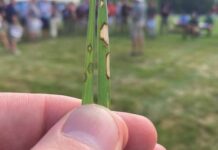Popular chemical products that U.S. farmers and turf care professionals depend upon to combat a range of plant pests remain under fire in much of Canada. We’re referring to neonicotinoids (neonics). Lawmakers in provinces and cities across our northern neighbor have these insecticides directly in their regulatory crosshairs.
At the risk of sharing what many of you may already know, here’s a brief backgrounder on neonics. Then, we’ll share what’s happening in Canada.
Neonics entered the market in the 1990s with the introduction of Bayer’s imidocloprid (Merit). Imidocloprid and other related molecules, such as clothianiden (Arena), thimetoxam (Meridian) and several other neonics act similarly on the nervous systems of plant pests, much like nicotine, hence the name. Neonics were developed in large part because they demonstrated reduced toxicity compared to previously used organophosphate and carbamate insecticides. But as the use of neonics surged worldwide this past generation, criticism aimed at them intensified fueled primarily by research suggesting they harm pollinators, including butterflies and honeybees.
In April 2013, this concern prompted a majority of member states of the European Union to vote in favor of implementing a ban on the use of imidacloprid, clothianidin and thiamethoxam on crops attractive to bees. The vote also affects the use of the pesticides by green industry professionals and private gardeners. In November 2017, the European Food Safety Agency began evaluating new data for the review of the restrictions for these three neonics.
The debate over the use of neonics rages in Canada, pitting well-funded “environmental” organizations against multinational chemical manufacturers, agricultural organizations and landscape/lawn/tree services providers – each group touting science to support their particular positions.
Consequently, a large range of stakeholders — farmers, fruit growers, green industry professionals and even beekeepers among others – now find themselves mired in a politicized issue that’s seemingly driven as much by emotion as by reason.
And the controversy shows few signs of lessening.
In November 2016, Health Canada proposed a ban on imidacloprid claiming that it is seeping into waterways at levels harmful to aquatic insects and the ecosystem. (Bees were not included in this particular risk assessment draft because that’s being done separately.) Health Canada is still reviewing the comments it received on the proposal to ban this popular neonic. It is expected to issue a final determination sometime in the spring of 2018.
Not content to wait for that report, Ontario, the country’s most populous province, and two major Canadian cities have taken action on their own.
Ontario is considering an 80 percent reduction in acreage planted in neonic-treated corn and soybean seed. The province already banned the use of almost all commonly-used chemical herbicides and pest controls on residential and commercial properties in 2009.
Then in 2015, the city of Montreal banned the use of all neonics, not just on residential and commercial properties, but also for golf courses and properties used for agriculture purposes. This past summer, the city of Vancouver in British Columbia outlawed using neonics (focusing on imidacloprid in particular) for treating home lawns, even those properties infested by chafer white grubs. In defending their decisions, lawmakers in both cities cited concern over the negative effects of these products on bees and other pollinators.
Issues surrounding the use of this popular insect control chemistry continue to percolate in the United States, too, but not to the same degree as in Canada or Europe. Not yet anyway. User groups here continue to monitor the situation and work with lawmakers, regulators and researchers along with educating product users on best practices.











![[VIDEO] Dickies®: Discover Workwear That’s Anything But Uniform](https://turfmagazine.com/wp-content/uploads/2023/06/1647663814-4b1a2a7742790a9b1e97a3b963477850192e1d6a9dfba9b07214a77bae25d6e3-d-218x150.jpg)






























![[VIDEO] Dickies®: Discover Workwear That’s Anything But Uniform](https://turfmagazine.com/wp-content/uploads/2023/06/1647663814-4b1a2a7742790a9b1e97a3b963477850192e1d6a9dfba9b07214a77bae25d6e3-d-324x160.jpg)